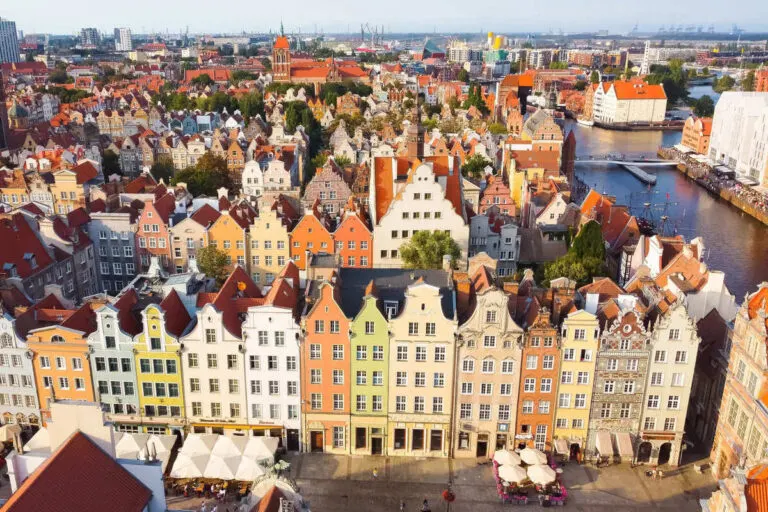With its UNESCO-protected canals and libertarian social scene, Amsterdam is a bucket list summer destination, but perhaps not if you’re on a shoestring budget, traveling on under $50 a day, or feel uneasy in crowded spaces:
It is one of the busiest tourist hotspots in Europe, with downtown hotels, if there are any left to book, costing from $200 to book per night, staggering levels of overtourism, and restrictive measures to combat it that could make you feel less welcome as a visitor.
Luckily, it’s not the only European city with stunning architecture and a scenic waterfront: straddling the Baltic Coast, this lesser-known Polish gem is the most perfect alternative.
Gdansk Is Amsterdam’s Colorful Polish Sister

Poland as a destination is already incredibly underrated, but if you do consider paying it a visit, it’s probably the towering high-rises of Warsaw, the well-preserved medieval center of Krakow, with the nearby Auschwitz memorial, that come to mind.
Little do most tourists know, however, that the Baltic region of Pomerania, lining the Northern European sea, is where they’ll find the prettiest Polish city.
It not only boasts a high concentration of landmarks but also bears a shocking architectural resemblance to Amsterdam.

Gdansk is a historic port that’s played a prominent role in European History, though that’s often understated: it was once a wealthy maritime power, going as far as rivaling its Dutch counterpart, and at one point, it was Europe’s most important shipbuilding hub.
To the curious onlooker, it looks like a Dutch or West Germanic city, and that’s not incidental: as part of the former Hanseatic League, the Gdansk cityscape took shape in traditional Northern Mannerist style, with rows upon rows of gabled houses.
A Fairytale City That Barely Looks Real

The difference is, while Amsterdam houses are mostly monochromatic and somber-toned, Gdansk’s are an explosion of color: strolling its Dluga, the main, long pedestrianized street cutting through the Old Town, you’ll see ornate facades in muted green, yellow, scarlet and blue.
Trust us, you’ll feel tempted to walk Dluga up and down, from its landmark Golden to Green Gates, more than just a few times, as the curling Germanic motifs are eye-catching, but there’s more to this colorful Amsterdam look-alike than the Instagrammable skinny buildings:
It is home to a rococo-Neptune Fountain, St. Mary’s Church, a red-brick Gothic marvel, the picturesque Mariacka Street, famous for its casual cafes, jewelry stalls and richly-decorated front porches, and the idyllic Radunia Canal, that could easily belong in the Netherlands.
Waterways have been just as central to Gdansk’s development as Amsterdam’s, and the city’s Motlawa waterfront is among the most charming in Europe, concentrating a number of centuries-old structures, like a 14th-century wooden crane dating back to the city’s shipbuilding era.

On top of the alluring medieval charm of it, History buffs should probably know Gdansk is the birthplace of none less than Daniel Fahrenheit, who invented the scale—if you’re strolling Dluga, you can’t miss Fahrenheit’s meteorological column.
It Is The Place Where World War II Started
Gdansk is one of the most historically-charged cities in Europe, not only due to the glorious medieval era it enjoyed but for a far darker, fascinating-all-the-same reason: it is the first free city the Nazis invaded in the lead-up to the Second World War, effectively triggering the conflict.
You read that right.
If you’ve ever wondered where exactly war was declared, you’re looking at it: this otherwise quaint, picturesque Polish city.
Gdank’s wartime, and post-war struggles are extensively documented in world-class museums, like the self-describing Museum of the Second World War, and the European Solidarity Centre, that deals with the Polish struggle for independence from the iron-fisted Soviet Union.
Tourists are also invited to visit Westerplatte, a peninsula infamous for having been the exact spot Nazis made landfall when approaching Gdansk from the Baltic Sea: though it’s a bit out of town, getting there is extremely easy with bus 106 or 138 (the journey takes 30 minutes).

Have We Been Sleeping On Pomerania All Along?
Gdansk is beautiful, but it is one city in a fairly big historical province called Pomerania: it is potentially one of the most fascinating regions in Poland, and a fairytale land dotted with castles and sleepy villages that look frozen in time.
Marlboro Castle, the largest castle in the world, the size of about 40 U.S. football fields, and a UNESCO World Heritage Site that once housed the Teutonic Order, is a short 42-minute train from Gdansk Central Station, tickets costing less than $3.

An even shorter 15-minute train away, Sopot is the unexpected beach resort you didn’t know you needed: with its numerous health spas, sandy beach bordering the azure Baltic, quirky Crooked House, and milder climate, it’s sure to give the scorching-hot Mediterranean a run for its money this summer.
Speaking of $$$, if you’re a budget traveler coming to Gdansk, then you’re in luck:
Gdansk Is Far Cheaper Than Amsterdam
Poland as a whole is among the cheapest destinations in Europe, and as it is often bypassed by tourists altogether, consumer prices in Gdansk are at complete odds with Amsterdam‘s, or other Northern European city breaks.

The local Slavic cuisine is to die for, with pierogi servings, flavorful stews and delicious beer, and the best part is, you’re unlikely to get set back more than $21 per outing in central Gdansk, against Amsterdam’s $47.
The average hotel price is much cheaper, too: $55 versus Amsterdam’s staggering $222, and total expenses for a one-week stay in Gdansk, and the wider Pomerania, come in at a reasonably cheap $782… still sold on Amsterdam instead?
That will be a minimum $1,392.
Credit: Source link



